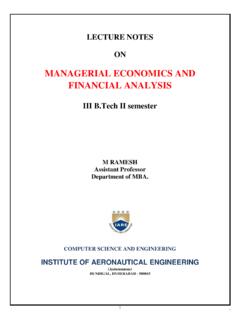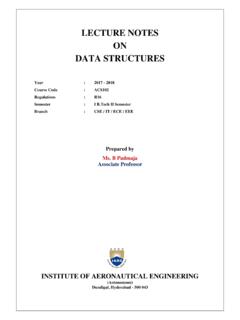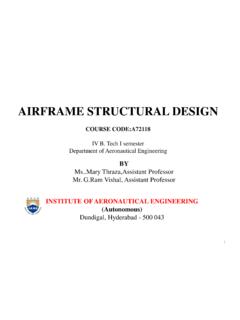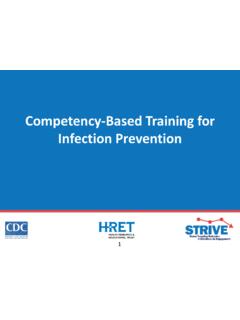Transcription of BASIC ELECTRICAL AND ELCTRONICS ENGINEERING …
1 BASIC ELECTRICAL AND ELCTRONICS ENGINEERING LABORATORY LAB MANUAL Academic Year : 2017 - 2018 Course Code : AEE103 Regulations : IARE - R16 Semester : III Branch : (ME / AE) INSTITUTE OF AERONAUTICAL ENGINEERING (Autonomous) Dundigal 500 043, Hyderabad Department of ELECTRICAL and Electronics ENGINEERING Page | 2 INSTITUTE OF AERONAUTICAL ENGINEERING (Autonomous) Dundigal, Hyderabad - 500 043 Department of ELECTRICAL and Electronics ENGINEERING Program Outcomes PO1 ENGINEERING knowledge: Apply the knowledge of mathematics, science, ENGINEERING fundamentals, and an ENGINEERING specialization to the solution of complex ENGINEERING problems. PO2 Problem analysis: Identify, formulate, review research literature, and analyze complex ENGINEERING problems reaching substantiated conclusions using first principles of mathematics, natural sciences, and ENGINEERING sciences PO3 Design/ development of solutions: Design solutions for complex ENGINEERING problems and design system components or processes that meet the specified needs with appropriate consideration for the public health and safety, and the cultural, societal, and environmental considerations.
2 PO4 Conduct investigations of complex problems: Use research-based knowledge and research methods including design of experiments, analysis and interpretation of data, and synthesis of the information to provide valid conclusions. PO5 Modern tool usage: Create, select, and apply appropriate techniques, resources, and modern ENGINEERING and IT tools including prediction and modeling to complex ENGINEERING activities with an understanding of the limitations. PO6 The engineer and society: Apply reasoning informed by the contextual knowledge to assess societal, health, safety, legal and cultural issues and the consequent responsibilities relevant to the professional ENGINEERING practice. PO7 Environment and sustainability: Understand the impact of the professional ENGINEERING solutions in societal and environmental contexts, and demonstrate the knowledge of, and need for sustainable development .
3 PO8 Ethics: Apply ethical principles and commit to professional ethics and responsibilities and norms of the ENGINEERING practice. PO9 Individual and team work: Function effectively as an individual, and as a member or leader in diverse teams, and in multidisciplinary settings. PO10 Communication: Communicate effectively on complex ENGINEERING activities with the ENGINEERING community and with society at large, such as, being able to comprehend and write effective reports and design documentation, make effective presentations, and give and receive clear instructions. PO11 Project management and finance: Demonstrate knowledge and understanding of the ENGINEERING and management principles and apply these to one s own work, as a member and leader in a team, to manage projects and in multidisciplinary environments. PO12 Life-long learning: Recognize the need for, and have the preparation and ability to engage in independent and life-long learning in the broadest context of technological change.
4 Page | 3 Program Specific Outcomes PSO1 professional Skills: Able to utilize the knowledge of high voltage ENGINEERING in collaboration with power systems in innovative, dynamic and challenging environment, for the research based team work. PSO2 Problem - Solving Skills: To explore the scientific theories, ideas, methodologies and the new cutting edge technologies in renewable energy ENGINEERING , and use this erudition in their professional development and gain sufficient competence to solve the current and future energy problems universally. PSO3 Successful career and Entrepreneurship: To be able to utilize of technologies like PLC, PMC, process controllers, transducers and HMI and design, install, test, and maintain power systems and industrial applications. Page | 4 INDEX S. No Name of the Experiment Page No 1 Verification of Kirchhoff s current and voltage laws.
5 7 - 9 2 Verification of ohms law. 10 - 12 3 Magnetization characteristics of DC shunt generator. 13 - 15 4 Swinburne s test on DC shunt machine. 16 - 19 5 Open circuit and short circuit test on single phase transformer. 20 - 24 6 Study the performance characteristics of three phase induction motor by brake test. 25 - 28 7 Determine the regulation of alternator using synchronous impedance method. 29 - 33 8 PN junction diode characteristics. ----- 9 Zener diode characteristics. ----- 10 Half wave rectifier circuit. ----- 11 Full wave rectifier circuit. ----- 12 Transistor common emitter characteristics. ----- 13 Transistor common base characteristics. ----- 14 Study of CRO. ----- Page | 5 ATTAINMENT OF PROGRAM OUTCOMES & PROGRAM SPECIFIC OUTCOMES Exp. No Experiment Program Outcomes Attained Program Specific Outcomes Attained 1 Verification of Kirchhoff s current and voltage laws. PO1,PO2 - 2 Verification of ohms law. PO1,PO2 - 3 Magnetization characteristics of DC shunt generator.
6 PO1,PO2 - 4 Predetermination of efficiency (Swinburne s test) of DC shunt machine. PO1,PO2, PO3 - 5 Open circuit and short circuit test on single phase transformer. PO1,PO2,PO4 - 6 Study the performance characteristics of three phase induction motor by brake test. PO1,PO2 - 7 Determine the regulation of alternator using synchronous impedance method. PO1,PO2 - 8 PN junction diode characteristics. - 9 Zener diode characteristics. - 10 Half wave rectifier circuit. - 11 Full wave rectifier circuit. - 12 Transistor common emitter characteristics. - 13 Transistor common base characteristics. - 14 Study of CRO. - Page | 6 BASIC ELECTRICAL AND ELCTRONICS ENGINEERING LABORATORY OBJECTIVE: The objective of BASIC ELECTRICAL and electronics ENGINEERING laboratory is to learn the practical experience with operation and applications electromechanical energy conversion devices such as DC machines, transformers, three phase induction motors and alternators.
7 It also aims to get the knowledge of the different electronic devices like diodes, rectifiers, transistors and how these devices are used in real time applications. It also makes the students to learn how to measure the ELECTRICAL quantities with different measuring devices and with CRO. OUTCOMES: Upon the completion of ELECTRICAL and electronics practical course, the student will be able to: 1. Understand the operation and applications of electromechanical energy conversion devices. 2. Understand identification and selection of various ELECTRICAL and electronic components. 3. Analyze the characteristics of various electronics components. Page | 7 EXPERIMENT 1 VERIFICATION OF KIRCHHOFF S CURRENT AND VOLTAGE LAWS AIM: To verify Kirchhoff s voltage law (KVL) and Kirchhoff s current law (KCL) in a passive resistive network APPARATUS REQUIRED: S. No Apparatus Name Range Type Quantity 1 RPS 2 Ammeter 3 Voltmeter 4 Resistors 5 Bread Board 6 Connecting Wires CIRCUIT DIAGRAMS: Circuit to verify KVL: Fig - 1 KVL To Verify KCL: Fig - 1 KCL Page | 8 PROCEDURE: To Verify KVL 1.
8 Connect the circuit diagram as shown in Figure 1. 2. Switch ON the supply to RPS. 3. Apply the voltage (say 5v) and note the voltmeter readings. 4. Sum up the voltmeter readings (voltage drops), that should be equal to applied voltage. 5. Thus KVL is verified practically. To Verify KCL 1. Connect the circuit diagram as shown in Figure 2. 2. Switch ON the supply to RPS. 3. Apply the voltage (say 5v) and note the ammeter readings. 4. Sum up the Ammeter readings (I1 and I2), that should be equal to total current (I). 5. Thus KCL is verified practically. OBSERVATIONS: For KVL Applied Voltage V (volts) V1 (volts) V2 (volts) V3 (volts) V1+V2+V3 (volts) Theoretical Practical Theoretical practical Theoretical practical Theoretical practical For KCL Applied Voltage V (volts) I (A) I1 (A) I2 (A) I1+I2 (A) Theoretical Practical Theoretical practical Theoretical practical Theoretical practical PRECAUTIONS: 1. Check for proper connections before switching ON the supply.
9 2. Make sure of proper color coding of resistors. 3. The terminal of the resistance should be properly connected. RESULT: Page | 9 PRE LAB VIVA QUESTIONS: 1. What is current? 2. What is voltage? 3. What is resistance? 4. What is ohm s law? 5. What is KCL and KVL? POST LAB VIVA QUESTIONS: 1. What do you mean by junction? 2. What directions should be assumed for KCL? 3. What are the positive and negative signs in KVL? 4. What is the colour coding of resistors? 5. What are the precautions to be taken while doing the experiment? 6. What is the range of ammeters and voltmeters you used in this experiment? Page | 10 EXPERIMENT 2 VERIFICATION OF OHM S LAW AIM: To verify Ohm s law for a given resistive network. APPARATUS REQUIRED: S. No Apparatus Name Range Type Quantity 1 RPS 2 Ammeter 3 Voltmeter 4 Resistor 5 Rheostat 6 Bread Board 7 Connecting Wires CIRCUIT DIAGRAM: Fig Circuit Diagram PROCEDURE: 1.
10 Make the connections as per circuit diagram. 2. Switch ON the power supply to RPS and apply a voltage (say 10V) and take the reading of voltmeter and ammeter. 3. Adjust the rheostat in steps and take down the readings of ammeter and voltmeter. 4. Plot a graph with V along x-axis and I along y-axis. 5. The graph will be a straight line which verifies Ohm's law. 6. Determine the slope of the V-I graph. The reciprocal of the slope gives resistance of the wire. Page | 11 OBSERVATIONS: S. No. Voltage (V) Current (mA) MODEL GRAPH: Fig: Voltage and Current Characteristics PRECAUTIONS: 1. Take care to connect the ammeter and voltmeter with their correct polarity. 2. Make sure of proper color coding of resistors. 3. The terminal of the resistance should be properly connected. RESULT: Page | 12 PRE LAB QUESTIONS: 1. What is current? 2. What is voltage? 3. Define charge. 4. Define power. 5. What is the resistance?

















